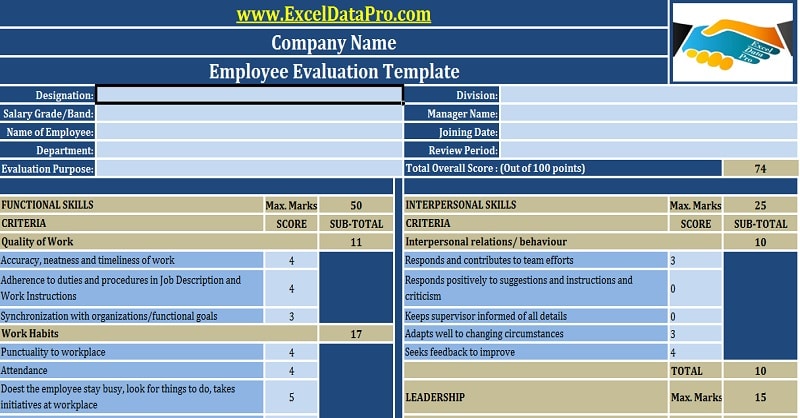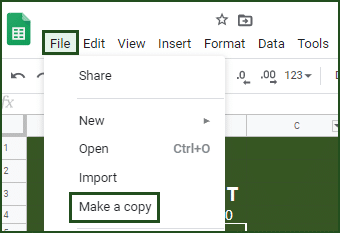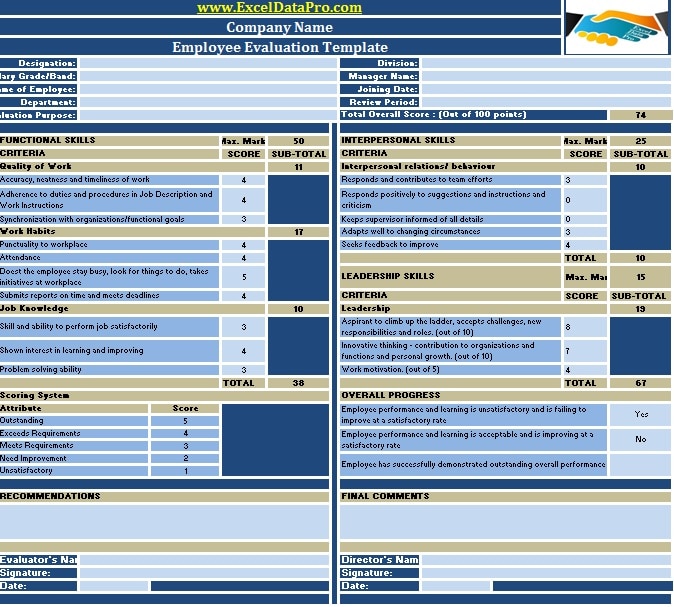
Employee Performance Evaluation Template is a ready-to-use template in Excel, Google Sheet, OpenOffice Calc, and Apple Numbers to conduct employee evaluation.
Moreover, this template consists of a predefined score system to evaluate functional, interpersonal, and leadership skills. All you have to do is to download your desired file format. Insert the scores based on the productivity of the employee.
Table of Contents
What Is Employee Performance Evaluation?
Employee Performance Evaluation is a key process to ensure that employees are performing right and where they can improve. As an HR professional, you can evaluate employees on a quarterly, half-yearly, or yearly basis.
Furthermore, such evaluations give us legal, ethical, and visible evidence of employee performance. It helps us to know, how actively they are involved, and how much they understand the job requirements.
Generally, the goal behind it is the development of employees and an overall improvement of the organization.
Purpose Of Employee Performance Evaluation
Performance Evaluation serves several purposes. The main objective of it is to improve check whether the employee’s output is by the industry norms. It also helps to uplift the overall productivity of the organization.
Such evaluation helps the employer look for employee weaknesses and instruct them to improve. It creates pressure on the employee to achieve a higher level of perfection. It benefits both the employer and the employee.
Eventually, this helps in building teams and improving communications. It leads to improved performance results.
The goal of this evaluation is to improve the way an organization functions. It is a key process that helps in achieving higher levels of customer satisfaction.
Moreover, these evaluations provide the employer to know the strengths of his team. YOu can use this data for scaling up of business and reshuffling of staff. Additionally, it helps an organization to arrange employee training and skill development sessions.
On an individual level, it helps an employee understand their abilities. It allows them to know where do they stand compared to others.
How To Evaluate Employee Performance?
Employee Performance is a 3 step process. You need to conduct in three different skill areas of an employee: Functional Skills, Interpersonal Skills, and Leadership Skills.
Functional Skills
Evaluation of Functional Skills includes the quality of work, work habits, and job knowledge of the employee.
Quality of Work consists of the following:
- Accuracy, neatness, and timeliness of work
- Adherence to duties and procedures in Job Description and Work Instructions
- Synchronization with organizations/functional goals
Work Habits consists of the following:
- Punctuality to workplace
- Attendance
- Taking initiatives at the workplace
- Submits reports on time and meets deadlines
Job Knowledge consists of the following:
- Skill and ability to perform the job satisfactorily
- Shown interest in learning and improving
- Problem-solving ability
Interpersonal Skills
Interpersonal skills evaluation consists of the following:
- Response and contribution to team efforts.
- Positive response to suggestions, instructions, and criticism.
- Coordination with supervisors.
- Adaption to changing circumstances.
- Seeking feedback for improvement.
Leadership Skills
Leadership skills evaluation consists of the following:
- An aspiration to grow
- Accepting challenges.
- Adhere to new responsibilities and roles.
- Innovative thinking.
- Work motivation.
Employee Performance Evaluation Template
We have created an easy to use Employee Performance Evaluation Template with predefined formulas and functions. This template can be helpful to manage the review process easily and efficiently.
Moreover, it consists of a predefined score system that will help perform this task easily.
Excel Google Sheets Open Office Calc Apple Numbers
Click here to Download All HR & Payroll Excel Templates for ₹299.
Important Note: To edit and customize the Google Sheet, save the file on your Google Drive by using the “Make a Copy” option from the File menu.

Additionally, you can download other HR documents like Salary Sheet With Attendance Register, Employee Mileage Log, and many more templates given on the left bar.
Let us discuss the components of this template in detail.
Contents of Employee Performance Evaluation Template
This template consists of 8 sections: Header Section, Employee Details Section, Evaluation Section, Score System Section, Overall Progress Section, Recommendations Section, Final Comments Section, and Signature Section.

Header Section
The header section consists of the company name, company logo, and the heading of the sheet ” Employee Evaluation Template”.

Employee Details Section
This section consists of the employee details as follows:
- Designation
- Salary Grade
- Name of employee
- Department
- Evaluation Purpose
- Division
- Manager Name
- Joining Date
- Review Period
- Total Score

Evaluation Section
Evaluation section consists of 3 areas of evaluation:
A. Functional Skills: It includes evaluations related to the quality of work, work habits, and job knowledge.
B. Interpersonal Skills: Interpersonal skill includes behavior and internal relation evaluations.
C. Leadership Skills: Leadership qualities of the employee are evaluated in this section.

The evaluation process differs from organization to organization. It can be edited according to the needs of the management.
Score totals display next to the respective skill headings.
Below the headings of each skill, you can find different questions based on the evaluation process. You need to just put the scores relevant to the employee performance in the blue boxes.
Totals are calculated automatically and added to the total score. The total score is displayed in the employee section.
Score System Section
The score system section has the scoring number from 1 to 5 for performance. 5 means outstanding and 1 means unsatisfactory.

Note: In the leadership skills section the first and second question scores are out of 10.
Overall Progress Section
The overall progress section consists of the overall performance of an employee in the organization.

Depending on the total scores of an employee, management can select a yes or no from the drop-down list against the questions.
Recommendations Section
In the Recommendation section, the evaluator can put any recommendations for the employee.

Final Comments Section
You can input the final comments related to the evaluation in this section.

Management Signature Section
The signature section consists of the signatures of the evaluator and the department heads.

Usually, the evaluation process differs from company to company. The aim of the evaluation is almost the same.
Thus, decisions like training, appraisal, promotion, demotion, and even termination of employees can be taken by a regular evaluation process.
Advantages of Performance Evaluation
- Regular, timely, and unbiased evaluations help employers to match employee qualifications to job assignments.
- It provides an assessment of individual strengths and weaknesses of employees and gives a brief idea about the collective talents by department or team.
- For training and development of employee skills, evaluations are necessary.
- It helps the employee to perform their job duties to meet their employer’s expectations.
- In many organizations, salary/wage increment or promotion depends on the performance. Thus, it helps in the recognition of employee efforts and defines their growth prospects.
- It gives the management an opportunity to recognize employee’s hard work, dedication as well as commitment.
- This allows the management to segregate highly proficient workers to assign additional duties and responsibilities, or even promote to a leadership role.
Disadvantages of Performace Evaluation
- Arbitrary standards can make an employee feel devaluated and underappreciated.
- Biased evaluations by supervisors or department heads can lead to employee dissatisfaction.
- If the performance evaluation is done poorly, the employees do not invest the energy and care that is necessary to genuinely improve.
- Strict evaluation often leads to higher anxiety levels in employees when they are unsure of what to expect.
- Frequent reviews make the evaluation meaningless and waste time.
- Too kind review by inexperienced managers or supervisors can lead to a decrease in the efficiency of employees.
We thank our readers for liking, sharing, and following us on different social media platforms.
If you have any queries please share in the comment section below. I will be more than happy to assist you.
Frequently Asked Questions
What is the ideal practice for conducting Performance Evaluations?
Usually, it depends on the industry. The ideal practice is to conduct performance reviews once a year. Some companies do it biannually or quarterly.
What preparations are necessary by an employee for performance evaluations?
The employee must keep notes of his accomplishments, training, and other issues that take place throughout the year. Moreover, an employee must self-evaluate himself/herself based on the previous year’s evaluation. Prepare points to be put up for discussion and suggestions for increasing performance.
Does every employee get an appraisal after the performance?
Appraisals depend on the company’s HR policy. Not every employee needs to get an appraisal or promotion.
What is the ideal time to be given for a performance review meeting?
Performance review meetings must be conducted before to inform all the employees about it. Later on, a minimum of 1-2 hours must be given to each employee individually to discuss the same one-on-one with them.